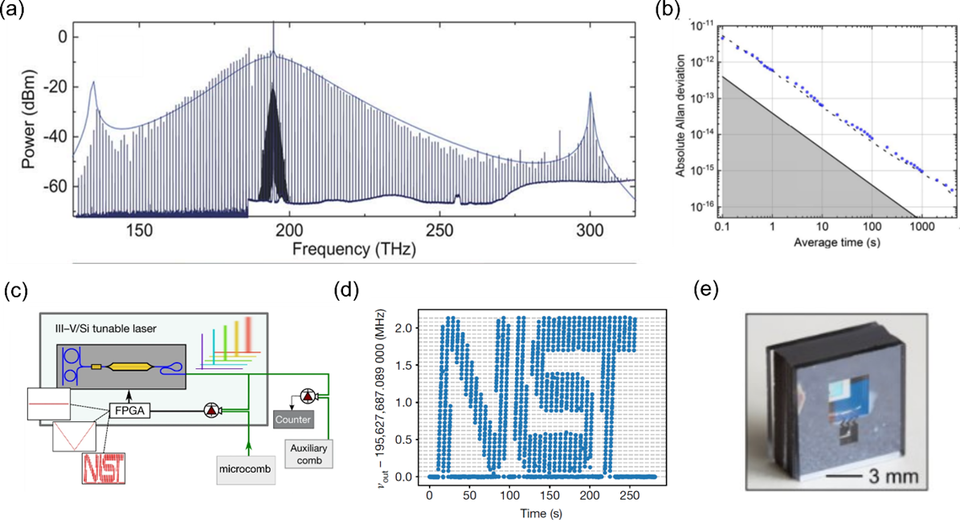Summary
Optical-frequency combs are versatile laser sources for precision, ultrabroadband measurements, including with time, frequency, chemicals, digital information, positioning and navigation, and generation of quantum states. Within the NIST-on-a-Chip Program, this project explores the generation of frequency combs via nonlinear optics with integrated photonics microresonators, which offer milliWatt threshold power for frequency conversion. Such microresonator frequency combs, or simply microcombs, are at the forefront of discovery research with completely novel states of light and new frontiers in semiconductor technology. We combine innovation in nonlinear optical science, advances in nanofabrication of integrated photonics, and ultraprecision time and frequency metrology to develop chip-scale frequency comb systems.
Description
The invention of optical-frequency combs opened many new applications in photonics from precision timing and ranging to generation of entangled states. They are composed of hundreds to millions of optical modes whose frequencies conform to a simple relationship, νn = n × frep +f0, where n is the mode number, frep is the repetition frequency, and f0 is the carrier-envelope-phase offset frequency; see Figure. Phase locking frep and f0 delivers to users a fully stabilized frequency comb, which can be derived from the SI second.

For NIST-on-a-Chip program, we are developing low-power consumption microcombs to support various time and frequency metrology applications. The microcombs are generated by Kerr nonlinear optics when a continuous wave (CW) laser is coupled to an integrated microresonator; a depiction of the basic setup and a scanning-electron microscope image of a microresonator are shown in the Figures. We reported the first demonstration of optical frequency synthesis with a microcomb. Our interlocked configuration of one silica and one silicon-nitride resonator leverages both nanofabrication and photonic-chip integration; optical spectrum measurements of these microcombs are show in the Figures. Our interlocked Kerr comb permits low-noise phase stabilization of its repetition and offset frequencies with respect to the SI second, and coherently reproduce their clock with a fractional precision of <6×10−13/τ, a behavior we verified through a 2 hour measurement to reach <3×10−16.

We locked a heterogeneously integrated III-V/silicon tunable laser to our fully stabilized interlocked comb to create a widely tunable optical frequency synthesizer. The laser frequency output of our synthesizer can be programmed by a microwave clock across 4 terahertz near 1,550 nm (the telecommunications C-band) with 1 Hz resolution. Significantly, our measurements verified that the output of the synthesizer is exceptionally stable across this region (synthesis error of 7.7×10−15 or below). An example of the tunability is shown in the Figures in which we programmed the synthesizer to create an optical frequency waveform in the shape of the NIST logo.
We have also demonstrated optical frequency division, where the frequency comb acts as a clockwork to coherently transfer the stability of an optical clock laser at frequency to all the comb modes and to a microwave signal derived from the comb repetition frequency, frep = (νn-f0)/N. In collaboration with the ADI Group, we demonstrated an architecture for a 2-photon optical atomic clock based on a microfabricated Rb vapor-cell. We used a clock laser with higher short stability and demonstrated that the absolute frequency noise of our microcomb reached 1 part in 1017.
For many years, significant obstacles associated with the pump laser stood in the way of realizing the idealized chip-scale comb source . Among these were high on-chip pump powers that compensated for inadequate resonator design and complicated methods to generate microresonator solitons. We have learned how to optimize the resonator design to achieve octave-spanning microcombs with only 40 mW of on-chip power, which is low enough to be pumped with a compact semiconductor amplifier. We explored the generation of an octave-span, Kerr-microcomb using hybrid integration of an InP distributed-feedback laser and a SiN photonic-integrated circuit. We demonstrate electrically pumped and fiber-packaged prototype systems, enabled by self-injection locking; see Figures. This direct integration of a laser and a microresonator circuit without previously used intervening elements, such as optical modulators and isolators, represents an important step toward realizing a self-referenced frequency comb with integrated photonics.

Publications
[1] T. C. Briles et al., Interlocking Kerr-Microresonator Frequency Combs for Microwave to Optical Synthesis, Opt. Lett., OL 43, 2933 (2018).
[2] T. E. Drake et al., Terahertz-Rate Kerr-Microresonator Optical Clockwork, Phys. Rev. X 9, 031023 (2019).
[3] D. T. Spencer et al., An Optical-Frequency Synthesizer Using Integrated Photonics, Nature 557, 7703 (2018).
[4] Z. L. Newman et al., Architecture for the Photonic Integration of an Optical Atomic Clock, Optica, OPTICA 6, 680 (2019).
[5] T. C. Briles, S.-P. Yu, T. E. Drake, J. R. Stone, and S. B. Papp, Generating Octave-Bandwidth Soliton Frequency Combs with Compact Low-Power Semiconductor Lasers, Phys. Rev. Applied 14, 014006 (2020).
[6] T. C. Briles, S.-P. Yu, L. Chang, C. Xiang, J. Guo, D. Kinghorn, G. Moille, K. Srinivasan, J. E. Bowers, and S. B. Papp, Hybrid InP and SiN Integration of an Octave-Spanning Frequency Comb, APL Photonics 6, 026102 (2021).
[7] S. B. Papp and S. A. Diddams, Spectral and Temporal Characterization of a Fused-Quartz-Microresonator Optical Frequency Comb, Phys. Rev. A 84, 053833 (2011).
[8] S. B. Papp, K. Beha, P. Del’Haye, F. Quinlan, H. Lee, K. J. Vahala, and S. A. Diddams, Microresonator Frequency Comb Optical Clock, Optica 1, 10 (2014).
Major Accomplishments
- First full stabilization of microcomb that is traceable to the SI second. The fractional stability <6×10−13/τ, reaching <3×10−16 after 2 hours.
- Demonstration of optical frequency division with microcombs at 1 part in 1017.
- First optical frequency synthesizer based on integrated photonics.
- Developed architecture for an optical atomic clock based on microcombs and a microfabricated Rb-vapor cell.

